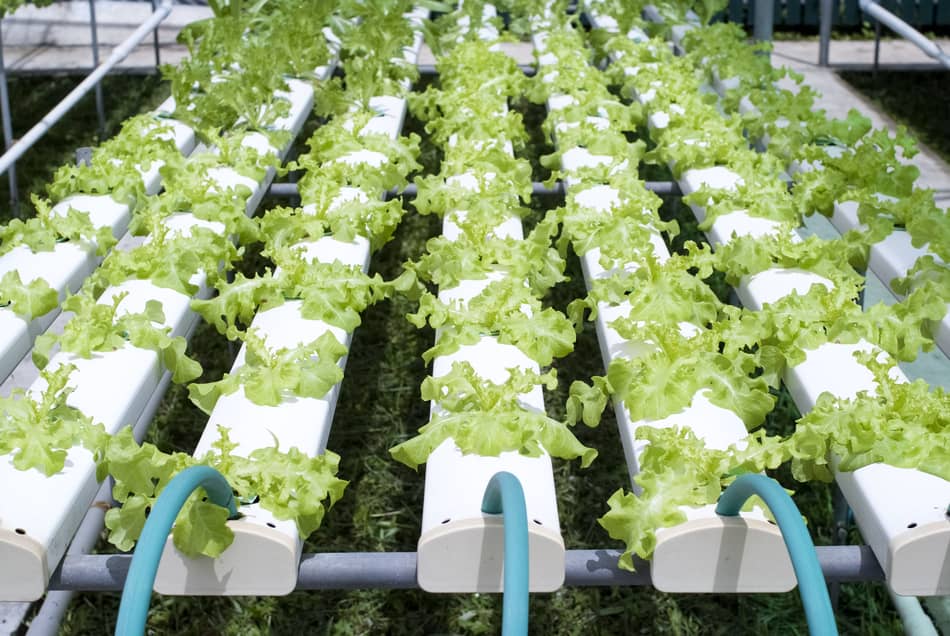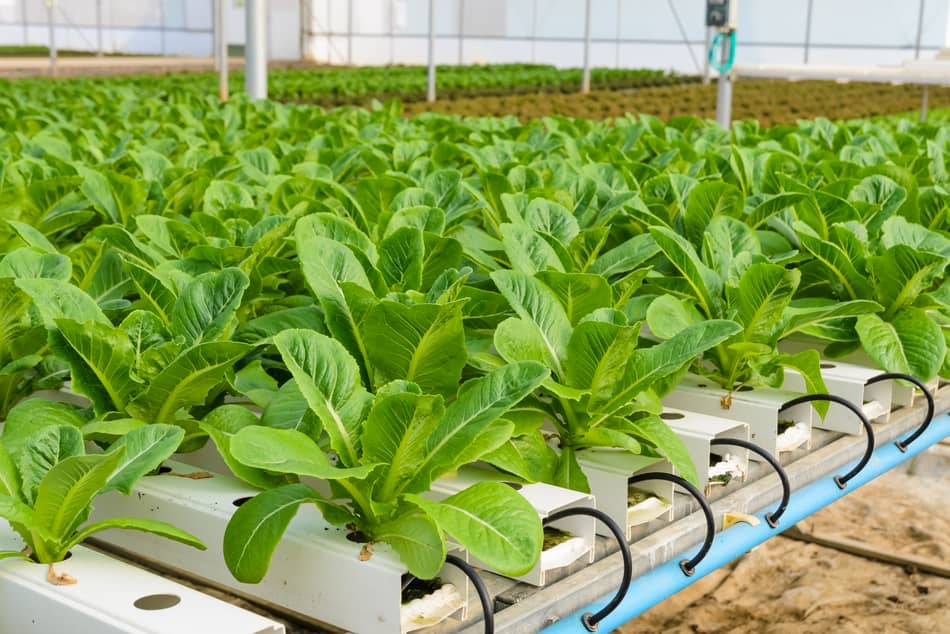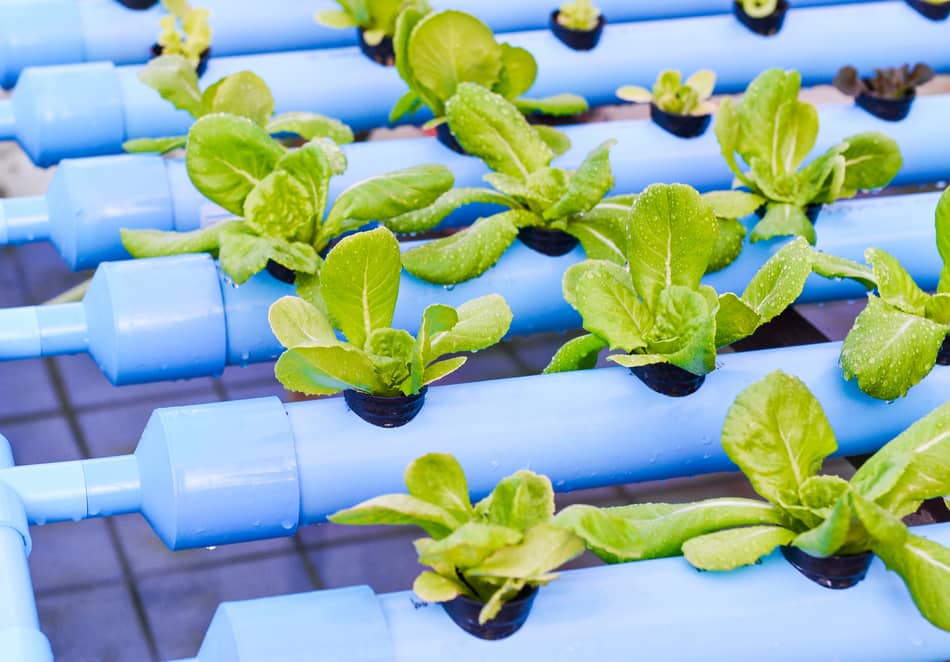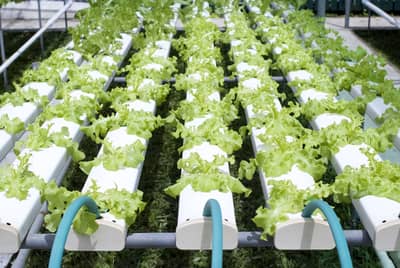Hydroponics can be a tricky business. Without soil & sunlight doing the heavy lifting, all the responsibility for your plants’ growth falls on you, the gardener. Knowing when, and how much, water & nutrients you should be adding to your hydroponic solution is crucial, but it’s just as important to know when to take them away.
Hydroponic solution should be fully changed out once the volume of added top-off water equals the total volume of the tank, usually around every two weeks. This prevents over-accumulation of nutrients, bacteria, and fungi. More frequent changes may be necessary if you’re having trouble maintaining proper pH and electrical conductivity.

How Often Should You Change The Water In A Hydroponic System?
Completely draining your reservoir and replacing the solution can seem to be a burden time-wise and money-wise. But, it’s absolutely necessary to maintain the ever-so-delicate balance of nutrients in your hydroponics setup.
If left unchanged for too long, ratios can be thrown out of whack and harmful organisms can flourish, stunting your plants’ growth, or worse. And that creates conditions where disease thrives, or even killing your plants.
Hydroponic solution changing schedule & frequency
Topping off your solution
As your plants are growing, you’ll notice that the water level in the reservoir drops a little bit every day, due to evaporation and transpiration. (Reminder: transpiration is basically how plants breathe, which causes water to evaporate from plant leaves).
To combat this loss of water in your hydroponic system, it’s important to add a little water to your solution periodically so that the volume remains consistent.
This process of gradually adding water to maintain fluid levels is known as “topping off”. The reason it matters is that nutrients like nitrogen, copper, and zinc, don’t exit the solution as readily as water does. And, having them become too concentrated can become harmful to your plant, especially to the roots.
Exactly how often you should be topping off is variable. Every 2-3 days is a good rule of thumb, but you can do it every day if you like. What is important is to measure how much water you are adding when you top off.
Once the volume of water that you’ve been topping off with is the same as the maximum volume in your reservoir, you will want to fully change out your solution.
 Hydroponic solution changing schedule & frequency
Hydroponic solution changing schedule & frequency
For example, if you have a 5 Liter reservoir and are adding 500mL of water every day, then you will need to do a full change every 10 days. If you have a 20L reservoir and are adding 1 liter per day, you can wait 20 days before doing a full change, and so on.
Usually, this will be in around the ballpark of two weeks (10-20 days), but it’s better to be exact if you can. Hydroponics is a fantastic way to grow plants, but is definitely more of a science than an art, so precision counts!
Perfect pH
pH, as you may or may not remember from chemistry, is the concentration of hydrogen ions, or acidity, in a given solution. It’s a complicated concept, but fortunately it’s pretty simple to understand in hydroponics.
The pH of your solution doesn’t directly affect your plants’ growth, but pH does affect how well plants can absorb the nutrients in their solution. If your pH is out of whack, the roots can’t take up all those tasty nutrients like they should. For most species, the ideal pH range is between around 5.5-6.5, though there is variation from species to species. Here are some examples:
| Species | Ideal pH Range |
|---|---|
| Mint | 6.5 - 7.0 |
| Basil | 6.5 - 6.8 |
| Chives | 6.0 - 6.5 |
| Broccoli | 6.0 - 6.5 |
| Cabbage | 6.5 - 7.5 |
| Cantaloupe | 6.5 - 6.8 |
| Garlic | 6.0 - 6.5 |
| Lettuce | 6.0 - 6.5 |
| Onions | 6.5 - 7.0 |
| Strawberries | 5.5 - 6.5 |
| Tomatoes | 5.5 - 6.5 |
| Peppers, Chilies, & Jalapenos | 6.0 - 6.8 |
| Oregano | 6.0 - 8.0 |
| Cucumbers | 5.8 - 6.0 |
| Carrots | 5.8 - 6.4 |
How to measure pH
Measuring pH is simple enough. You can purchase pH test sticks cheaply at your local hydroponics supply store (they can also be found at pool stores and aquarium supply stores) or online.
Dip them into your solution, watch them change color, and then check the back of the box to see what pH this corresponds to.
It’s a good idea to check your pH on a daily basis, at least to start with.
Managing pH in your hydroponic system
You can expect pH to fluctuate slightly in between solution changes. Typically, it will start at the lower end of the range and gradually rise.
If you find that your pH is getting to high or too low for your liking, there are ways to modify it somewhat. To adjust pH, you can either use a commercial “pH up” and “pH down” products, or with home goods like vinegar.
Like with the water level, you need to keep your solution’s pH at just the right level for optimal growth. However, modifying your reservoir water by adding pH altering products isn’t always a good long term solution (no pun intended). They’re typically short lasting, and won’t fix fundamental pH imbalances in your solution. Fully changing out your solution will, though!
Sometimes pH additives only work in the short term.
If you notice that your pH has been consistently out of the proper range–even after adjusting it using additives, then it might be a signal you need to do a full water change-out.
It’s difficult to fully predict exactly how your pH will change over time, and if you’re noticing regular problems then it’s probably best to change the water out.
NOTE:Be sure to use pH balanced water in your reservoir! Normal water has a pH ofexactly 7.0, which is what you’re looking for. Tap water or garden hose watermay be more or less acidic. pH test your water before adding it to yoursolution.
Conducting Conductivity Tests
There’s one last variable you need to be aware of: your solution’s electrical conductivity. Electrical conductivity, or EC, is a measure of how well your solution can conduct an electric current. Without getting too deep into the chemistry of it, most of the nutrients in your solution are really good at conducting electricity. Therefore, the higher your EC, the greater your nutrient concentration is.
When you first mix your solution, measure its EC value using a “conductivity meter”, readily available online or at hydroponic supply stores for $15-20. Your goal will be to keep the EC the same as it was when you first mixed your solution throughout the growing process. Too high of a nutrient concentration can cause major problems for your plant’s roots and too low would obviously lead to undernourishment.
Similarly to your pH levels, you can adjust the EC of your solution by simply adding nutrients or diluting with water. But again, if you notice consistent issues with your EC that cannot be fixed with relatively minor adjustments, it be necessary to do a full change out to make sure things stay in balance. When you’re first starting out with hydroponics, make it a goal to test your EC every day.
 Reasons to change hydroponic solution
Reasons to change hydroponic solution
Other reasons to change the hydroponic solution
There are a few more situations in which it would behoove you to change your hydroponic solution:
- Whenever you change your nutrient ratios. This one is pretty self-explanatory; if you’re making a big change in the ratios of your nutrients, then you’ll need to flush out your tank and start from scratch with a new solution.
- There are visible signs and symptoms of unhealthy nutrient imbalances and/or bacterial growth. These may include:
- A yellowing of your plant’s leaves, known as chlorosis
- A purplish tint appearing throughout your plant, conveniently known as “purpling”
- Necrosis, or death, of sections of leaf or roots
- Stunting. If a certain part of your plant is growing at a much slower rate than others, or if the whole plant has very delayed growth, then it would be a good idea to discard your solution and start again.
Related Questions
How long does hydroponic nutrients last?
Hydroponic nutrients can typically last 7 – 10 days, assuming you drain, clean, & remix your nutrients, and top off the system with plain water daily. The nutrient strength will diminish as plants absorb the nutrients in the system.
Can you grow hydroponics without nutrients?
Yes, but plain water won’t contain sufficient nutrients for proper plant growth. The advantages of hydroponics are that you don’t have to rely on soil for providing plant nutrients, and you can precisely control the balance of nutrients your plants receive.
What can I do with my used up hydroponic solution?
Making and balancing hydroponic solution is a lot of work, and it’s disappointing and a little wasteful to simply toss out that valuable, nutrient-rich plant juice. Fortunately, you can spread the love to your outdoor plants, too! If you dilute the wastewater 50/50 with tap water, and then spread it on your flowerbed or outside garden, the plants there will love it.
NOTE: If you don’t have any outside plants to share with, dispose of your wastewater down the drain. If you dump your water outside and it flows into a creek or other water source, it can easily unbalance the nitrogen ratios of that ecosystem and damage the species living there.
Are hydroponically grown foods as good for you as traditionally grown foods?
They absolutely can be! It all depends on how well you nail the nutrient balances. There’s no mysterious element in outside soil that makes plants grown traditionally have more or less nutritional value than hydroponically grown ones. This goes for flavor, too. Well-grown hydroponic fruits, veggies, and herbs can taste just as good as those from the farm.
What’s more, when you grow your own plants hydroponically, you can be sure that they were raised free from pesticides and other potentially harmful chemicals that outdoor plants may be exposed to.


